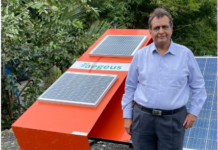
The internet of things (IoT) – that ever-expanding ecosystem of digital sensors, home appliances and wearable smart devices – attracts its fair share of attention. Speculation is rife on how the 23bn-odd (and counting) “things” will improve quality of life, streamline business operations and ultimately fuel economic benefits to the tune of up to $11tn per year by 2025.
Less often considered is the cost to the environment of such a vast network of devices. With the full extent of the IoT far from being realised, even experts are divided on whether it will spell doom or salvation for the environment.
One thing that experts can agree on is that we shouldn’t wait around to find out.
“The internet of things will be the biggest, most sophisticated piece of equipment that we’ve deployed across the planet – ever,” says telecommunications expert Kerry Hinton, former director of the Centre for Energy Efficient Telecommunications at the University of Melbourne. “That means that we’ve got to think about the potential limitations on it due to power consumption, the use of rare earth elements – all of that – from day one.”
According to Hinton, how energy hungry the IoT will be largely depends on the types of devices deployed and what they will be doing.
At one end of the spectrum, low-power, low-data transmitting devices – such as sensors that monitor when vending machines need a refill – are unlikely to send energy bills through the roof. Indeed, many of these simple devices won’t tap into a building’s mains power at all. Long-lasting batteries will do most of the work and devices that can power themselves, by tapping into sunlight, vibrations or heat, are also in development.
However, Hinton and others foresee an ecosystem of increasingly complex and energy-hungry devices emerging. Devices using video surveillance are a good example. Not only will these devices require mains power to function, they will also contribute significantly to the growth in data coursing through the internet’s veins. According to Cisco’s visual networking index, an ongoing survey of data-consumption trends, internet video surveillance traffic almost doubled between 2014 and 2015, and is set to increase tenfold by 2020.
The problem of energy consumption will be a pernicious one, says Hinton. “These technologies on a device-by-device basis, or even a house-by-house basis, are not a significant additional contribution to overall power consumption,” he says. Multiply that across Australia though and “that’s going to boil down to another power station or another two power stations”.
Far from being energy gluttons though, IoT devices could contribute to substantial energy and water savings, according to Bettina Tratz-Ryan, green IT specialist and research vice-president at Gartner. “Concepts like energy harvesting are a huge component of innovation that the IoT, specifically, can drive,” she says. In addition, sensors will allow smart buildings to ramp up temperature controls when needed, dim lights when nobody’s around and alert maintenance crews to water leaks as soon as they happen.
This is exactly the kind of application fledgling IoT company SkyGrid is developing. “There’s a lot of gimmicky stuff out there but we’re interested in something that changes and improves the world,” says the company’s chief executive, Rory Gleeson.
SkyGrid, which is based in Melbourne and Sydney, is developing a smart hot-water system in partnership with hot-water company Quantum Energy. The aim is to intelligently control when a building’s hot-water systems are switched on, so that energy isn’t wasted heating water when no one is around to use it – something that currently wastes as much as 50% of a system’s power.
Of course the “things” are only one component of the IoT. The sheer volume of data being transmitted and stored is also set to explode. Data storage has become more energy efficient over recent years. Instead of being relegated to servers held in energy-inefficient company backrooms, data is increasingly stored and processed in the cloud. That’s to say, in large server farms operated by tech giants who have an interest in keeping energy consumption (and costs) to a minimum.
Tech giants are turning to renewable energy to lessen their carbon footprint, according to Greenpeace’s 2015 Clicking Clean report. Apple’s data centres, for instance, boast 100% renewable energy, with Yahoo (73% renewables), Facebook (49%) and Google (46%) also improving their green credentials with renewables. (By contrast, Australia-based data centres for HP, IBM and Microsoft get 74% of their energy from coal-fired power).
Companies are also strategically locating their data centres for improved energy inefficiency. In 2013, for example, Facebook opened a data centre in northern Sweden that is cooled with outside air and runs off local hydroelectric power.
Because of these efficiencies, the deluge of data from the IoT, if stored in the cloud, won’t have a huge impact on energy consumption. But much of the IoT won’t be run off the cloud, says Hinton. Applications that require rapid data access and response times – such as health monitors and autonomous vehicles – will need data to be stored locally and efficiency gains from offshoring of data storage could diminish.
Keeping data local isn’t all bad, according to Tratz-Ryan. “Devices are talking to each other without the data being pushed back into the network, which uses energy, which produces carbon,” she says.
The Melbourne-based IoT company Freestyle takes advantage of this decentralisation of data to make more responsive energy grids. “It’s taking the intelligence away from centralised control and letting the devices make decisions on near-real-time events,” says its business development general manager, Brad Affleck.
Freestyle has partnered with engineering firm PowerTec, South Australian utilities provider SA Power Networks and the University of Adelaide on an intelligent energy grid for Kangaroo Island in South Australia. Sensors and controllers in the grid intelligently manage energy sources to sway energy consumption towards renewables without sacrificing the reliability of the supply.
With so many factors on either side of the environment ledger, crunching the numbers to determine whether our connected lives are good or bad for the environment is no mean feat.
But the Global e-Sustainability Initiative (GeSI), an international consortium of tech companies and telcos, has attempted just that. In 2015, GeSI released its #SMARTer2030 report, which suggests that information and communications technologies, including the IoT, will be able to save almost 10 times the carbon dioxide emissions that it generates by 2030 through reduced travel, smart buildings and greater efficiencies in manufacturing and agriculture.
While Tratz-Ryan is optimistic that this vision of the future is achievable, Hinton isn’t convinced. “The tricky bit,” he says, “is you’ve got to get people to do it” – a “non-trivial exercise” that will require significant public policy intervention.
For Tratz-Ryan, policy is only one piece of the puzzle. More important will be peer pressure that encourages organisations and individuals to behave in a socially responsible way. “Policies are not enough to drive energy efficiency and climate change initiatives,” she says. “It has to come from the user community and it has to come from industry.”
Source: https://www.theguardian.com


















